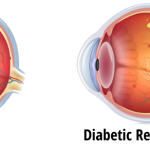
Understanding and Managing Dry Eye Syndrome
What is Dry Eye Syndrome?
Dry eye syndrome, also known as Keratoconjunctivitis Sicca, is a condition where the eyes do not produce enough tears, or the tears produced are of poor quality. Tears are essential for keeping the eyes lubricated, reducing the risk of infection, and maintaining clear vision. Without enough tears, the eyes can become dry, red, and irritated, leading to discomfort and even vision problems.
Causes of Dry Eye Syndrome includes:
- Age: As age of a person progresses, the natural tendency to produce tears decreases gradually.
- Gender: Women are more likely to develop dry eye syndrome than men, particularly during hormonal changes such as menopause.
- Medications: Certain medications, such as antihistamines, decongestants, and antidepressants, can reduce tear production and cause dry eye syndrome.
- Medical conditions: Health conditions such as rheumatoid arthritis, Sjogren’s syndrome, and thyroid disorders leads to dry eye syndrome.
- Environmental factors: Exposure to dry air, wind, and smoke can cause dry eye syndrome, as can prolonged screen time and contact lens wear.
Symptoms of Dry Eye Syndrome includes:
- Dryness or Grittiness in the eyes
- Redness
- Irritation
- Blurred Vision
- Sensitivity to Light
- Watery eyes (Reflex tears)
- Difficulty in wearing contact lens
Treatment Options for Dry Eye Syndrome:
- Artificial Tears: Over-the-counter artificial tears can be used to lubricate the eyes and provide relief from dryness.
- Prescription Medications: Prescription eye drops can be used to increase tear production or reduce inflammation.
- Punctal Plugs: These tiny devices can be inserted into the tear ducts to block tears from draining, keeping the eyes moist.
- Warm Compresses: Applying warm compresses to the eyes can help unclog the blocked oil glands in the eyelids, improving tear quality.
- Lifestyle Changes: Making lifestyle changes such as taking breaks from screens, increasing humidity levels, and avoiding smoking can help reduce dry eye syndrome symptoms.
Managing and Preventing Dry Eye Syndrome:
- Blinking Regularly: Regularly blinking can help keep the eyes lubricated and prevent dryness.
- Taking Breaks from Screens: Taking breaks from screens and practicing the 20-20-20 rule (looking away from screens every 20 minutes for 20 seconds) can help reduce eye strain and dryness.
- Wearing Sunglasses: Wearing sunglasses can protect the eyes from wind, dust, and sunlight, reducing the risk of dry eye syndrome.
- Increasing Humidity: Increasing humidity levels in the home or workplace can help keep the eyes moist and reduce dryness.
- Avoiding Smoke: Avoiding smoking and exposure to secondhand smoke can reduce the risk of dry eye syndrome.





